Anchorage, a heaven for a Jeep
Many years ago Brad Sawyer wrote me. His letter went as follows: I read your mention of the various modified jeeps: tow, farm...etc During vacation, I saw and got a pic of an Anchorage Alaska airport J-truck modified to move float-planes. Have you seen this highly modified truck or would you like a copy of my pic? I dont know about the ethics of sharing pics of someone else's rig. Now brad's not a light weight with Jeeps. He owns a few:
When a man with this many Jeeps writes me, I listen. It may take a while but I do listen. Brad was referring to the previous Jeep Creep, Fidel, in an column he wrote, if you want to take a look at it, here it is: Fidel's Jeep Creep Column July, 2003 Brad and Fidel are right about Jeeps being used for almost anything. The more bizarre the more fun they are to see. We can only speculate on what has been done over the years to Jeeps that will never come to the light of day. In the Philippines they use Jeeps as taxis. In India Jeeps are still being manufactured that look a whole lot like the CJ series. In France Jeeps were licensed and they made the MB series for several years post World War II. Then of course there's the glut of vehicles that were based on the Jeep. The original Land Rover was based on the the MB. The Toyota was first based on the CJ2. Then Mitsubishi licensed a Jeep like vehicle. The list goes on and on. At the close of World War II the Jeep was being transferred from military to civilian production. To help boost after-war sales Jeep attempted to reach the farmers. Lots of GI's were coming home from the theaters of war with fond memories of Jeeps. These little versatile vehicles had saved many of their lives. It was personal with them. They loved their Jeeps. When one was destroyed the were distraught. Jeeps were field stripped and parts went into other Jeeps to keep the military fleet running smoothly. These mechanics and drivers knew just how tough and simple the Jeeps were to maintain. When they got home they wanted to have something as tough as strong as the Jeep. A tractor just wasn't the same. You could plow with a tractor, but you couldn't drive the tractor to town with your best girl. You couldn't take that tractor over the mountains when the roads were iced over. You could take the tractor into the plows, but you couldn't travel at 50 miles per hour into town to buy supplies with a tractor. You could with a Jeep. So, in the effort to reach out, cross over and make money in 1944 Jeep introduced the Argi-Jeep for production. It wasn't much to look at, but it was functional. The engineers were doing what they did best, manufactured with the rule of function over form. This Jeep was made to work, and work hard. You bought the Jeep and started adding things like:
These items were tools used everyday on the farm and made the Jeep more than a way to get into town, or through a muddy field. These engineers continued to turn it into a more useful mule. They even were turned into a helicopter during World War II by the British Royal Air Force called the Rotor Jeep. I'd love to have one of those to fly all over the Palouse! That's my idea of fun, and it brings me to one more saga of the Jeep from the Anchorage Airport. If you've ever been to Anchorage, it's a great place. I was there last in 1985. I was working at the BLM. It was an enjoyable trip. The plain almost crashed on the runway, sheer winds almost destroyed the aircraft; and a drunk was pretty unruly till the communications systems fell out of ceiling. The aircraft hit the ground the access panels came down and the equipment broke it's retaining chains and almost fell into the drunk's lap. He sobered up fast. I don't think that he'll fly first class again! It was a real experience, one that I fondly remember. As a child I'd fly out of Seward or Valdez and go to Anchorage in a bush plane. These little planes were the Jeeps of the air. They could go anywhere, and do almost anything. Their pilots were among the most gifted pilots I've ever met. They could feel their way through the air and find that little dirt/grass runway from 10,000 feet above the clouds. They could find a strip where there was note, by landing on water or snow, and even ice. These men and planes were made up of many of the pioneers in Alaska. Without them there would be no one there. They brought freight, food, books, heat, generators, dogs, and people into the bush where even angels would not tread. They could spot a hole in the clouds and drop down, or climb up to the heavens through that hole. Like a Jeep, nothing is forever. Those planes went down, and when they did, they went down hard. Often you never knew where they were, or in what condition they were in when the aircraft went down. The conditions there could change on a dime. I remember in Anchorage walking around the house and having rain in the front yard, sun in the back and sleet on the side yard. Go five miles or wait five minutes. When that aircraft goes down you want to get to them quickly. That's where the Anchorage Squadron (among many) of the Alaskan Civil Air Patrol Wing swings into action. As a former Senior Mst. Sgt. in the Washington Wing about 4 decades ago I can attest to the fact that every minute counts when your looking for an aircraft. Every search begins on the ground and the faster you can get a search aircraft in the air, the faster you can render aid, or bring aircraft crew and passengers home. Seconds count, they always have and they always will. Which brings us back to Brad, and what he saw at the Anchorage airport. Take a look at some very unusual Jeeps. How do you get a airplane mounted on pontoons into the water? A way to do that is with a Jeep! Yes, a Jeep.
Have you ever seen such a Jeep? I hadn't. The Civil Air Patrol surplus receives goods from the Dept. of Defense. This J10 was one of them. It was donated, and from the color, from the USAF. The the bed, fuel tank and rear wheels were removed along with some of the frame. What in the heck is this for? The hydraulics and the rear wheels were then added on to the rear of the vehicle's frame. Let's look closer at the rear bed of the Jeep.
What has been done here is to install some pretty nice hydraulics coupled to the new frame. There's no driveshaft to the rear wheels. The Jeep does not need it, that's not why it's been altered. Look a little closer at the hydraulic cylinders. They're there to form a lift. They are coupled to the white portion of the reworked frame. That frame lifts. You've all seen motorcycle lifts in catalogs where you can drive your motor ycle up on the lift and then lift it up to work on it. This isn't much different. All it does is lift the white portion of the frame up. Why? What's the fastest way to get an aircraft in or out of the water? It's to put it on a trailer and tow it from the hanger (or tie-downs) to the water and back. Now remember this is Alaska. It's a tough place for weather. You'd best make sure your aircraft is tethered, if not in a hanger. You don't leave it in the water for any length of time unless you want to see a float plane sink. That's a good way to really ruin your day. So, this Jeep's backed up to the aircraft, and the aircraft is affixed to the Jeep's frame. The frame is then lifted via the hydraulics and the Jeep can then move the aircraft to the water efficiently.
One plus for the Jeep is that, because this is Alaska, it can get cold and the Jeep has a self enclosed cab and it was four wheel drive. If you remove the rear drive you can just shift the transfer case to 4W high, or 4W Low and drive on with front wheel drive only. That's a plus. Where else can a struggling group of volunteers get something as perfect as a Jeep for free? This didn't grow on a tree. The CAP personnel put some time and money into altering the Jeep to save lives. That's it's purpose, pure and simple. You'd think that one Jeep tug like this would be enough. But think again. When you've got several aircraft in the air they're range and fuel capacities are very similar. That means that they'll often go out and fly their search patterns and return within a few minutes of each other. You've got to get them in and out fast for service fuel (if the dock's closed) and back into the air. You don't want a traffic jam to delay anything. The ground crews can go into action as fast as the aircraft crews. A second tug is needed, and that's what they have.
Also what happens when you've only got one tug and it breaks down. You don't want that to happen when you're in the middle of a mission. This J2000 is a little rough, and being prepped for some work. Again, take a look at the hydraulic lines. Notice the lights pointed BACKWARDS to view the aircraft as you align the frame of the Jeep with the pontoons of the aircraft? It's nice to see where you're going. Also, that rear window slides if you need better visibility.
How could you improve this setup? It's a tall order, but when you've got a little money, time and a few ideas you can. Time marches on, and these Jeeps have spent a lifetime in a very special service. Time does move on. It leaves behind that which can't progress with the times. These Jeeps have been left behind, and will be replaced when they're no longer useful. Will it be another Jeep? Who knows? Jeep's not made a pickup for the last couple of decades. To cut a Jeep in half would be pretty darned silly. So, the locals have decided to upgrade to GM vehicles. Here's what they're using.
Here's a better view of just what happens when you put the frame of the vehicle under the frame of the aircraft.
The best thought on this C10 is that you can easily drive forward to the aircraft and side the frame under it's frame. It reduces possibilities of accidents.
Now how about a little more bling, and some accesorization? They have it!
If you look you can see that the step is removable. But if you've got to work on an aircraft, it's a good idea. You've got a stable platform to reach the aircraft without ladders. In the Alaskan weather, that's a huge boon. Oh, and if you get to Alaska, there is also a few other places to see. In Anchorage the museum is a great place to spend a few hours looking into Alaskan history. If you're in Anchorage, don't miss it, you'll be sorry. I've spent many hours there tracing the movements and happenings of the Good Friday Earthquake. Brad and Deb didn't miss the opportunity, don't you miss it!
If you're out and about and see unusual Jeeps, snap a few pictures and send me an Email. I'd love to see them, and I'd bet the rest of ORC's readers would enjoy them as well. |

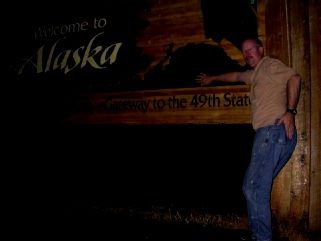
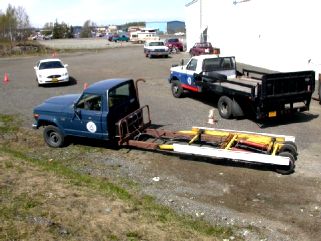


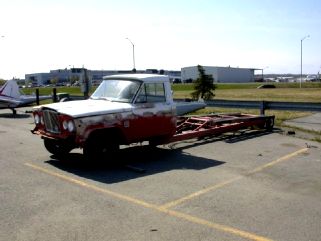
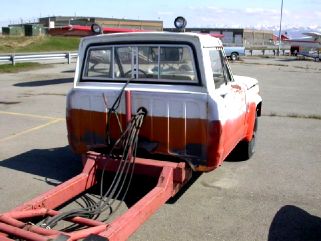
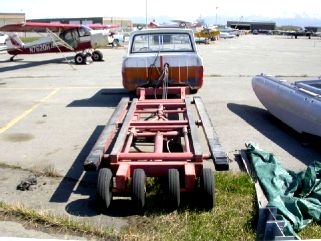
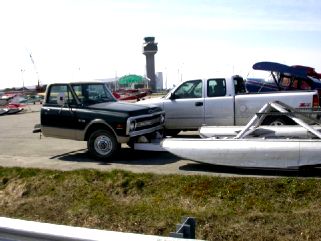
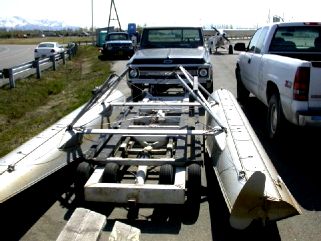
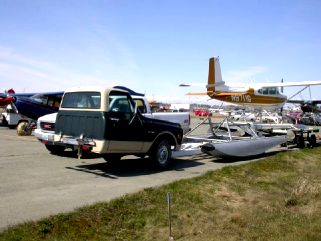
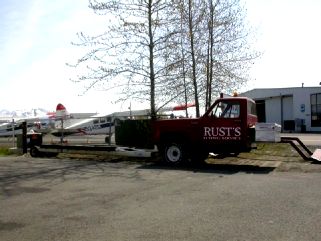

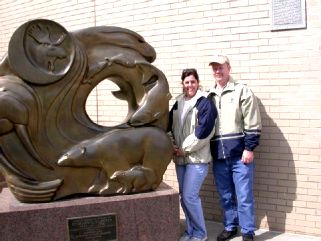

 Your Privacy Choices
Your Privacy Choices